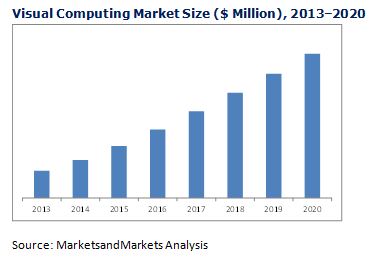The visual computing market has evolved at a high rate. The technology has revolutionized to such an extent, that a broad range of industries with numerous applications optimized to tackle complex challenges in the field of graphics and 3D modelling and accelerating high performance computing across the key verticals such as gaming, media & entertainment, healthcare, automotive, and so on. Post 2000, the market has witnessed various advancements after the launch of Microsoft Kinect which is a product for gaming consoles of the Xbox 360 launched by Microsoft (U.S.). In 2014, the Americas accounted for the largest share of the visual computing market.
Browse 65 market data tables and 66 figures spread through 145 pages and in-depth TOC on “Visual Computing Market – Global Forecast to 2020″
Companies in the Americas are leading in the global market by implementing several innovative technologies. The visual computing market is endorsing a rampage of contracts, partnerships, agreements, mergers, acquisitions, expansions, new product launches, and other activities in the research and development field.
The main building blocks of the value chain of the visual computing market are: component manufacturers, software solution providers, technology integrators/ licensors, and the end-users. In 2014, the gaming vertical accounted for the largest share of the overall visual computing market. While considering the market leadership, Nvidia Corp. (U.S.) is ahead of all other players in this market.
Nvidia Corporation was founded in 1993 and is headquartered in California, the U.S. The company has two business segments: namely GPU and Terga Processor and it deliver technologies for each of the computing platforms. Nvidia has two decades of experience in visual computing and computer graphics and is one of the prominent players in visual computing market. The company serves all the major challenging in the computing market such as gaming, design & visualization, HPC & data centers, automotive, and smart devices. The company has more than 40 offices worldwide and has its presence across all the major regions namely the Americas, Europe, and Asia.
Intel Corp. (U.S.) is also a prominent contributor in the visual computing ecosystem. It was founded in 1968 and is headquartered in California, the U.S. Within the visual computing market, Intel has wide operations of processors and HD graphics processors, and chipsets. It designs and manufactures processors, motherboards, chipsets, server products, Ethernet products, wireless products, consumer electronics products, and solid state drives among others. It is functional through operating groups such as PC Client Group, Data Center Group, Internet of Things Group, Mobile and Communications Group, and Software and Services operating segments. Intel’s strategy of selling platform solutions includes integrating a CPU and a GPU on the same chip or same package.
Some other major players in this ecosystem include Advanced Micro Devices, Inc. (U.S.), ARM Holdings plc. (U.K.), Marvell Technology Group Ltd. (Bermuda), Imagination Technologies Group Plc. (U.K.), and so on.

